- Department of Hepatobiliary Surgery, Suining Central Hospital, Suining, Sichuan, China
Background: As the endoscopic retrograde cholangiopancreatography (ERCP) is commonly used, some rare ERCP-related perforation cases have garnered attention. This study aims to report a rare case of Stapfer IV injury accompanied by severe infections and review the appropriate treatment methods for patients with different types of Stapfer IV injury.
Case summary: A female patient received ERCP treatments, but she soon presented with massive diffuse abdominal and thoracic gas accompanied by severe infections. In the following upper gastrointestinal radiography examination, no signs of gastrointestinal perforations were observed. After receiving antibiotic treatments and percutaneous transhepatic gallbladder drainage therapy, the patient recovered and was discharged. Finally, she was diagnosed with Stapfer IV injury and cholecystitis.
Conclusion: Simple Stapfer IV injury was not a true perforation, and the conservative treatment was feasible. When a severe infection occurs in a patient with Stapfer IV injury, the other complications of ERCP procedures, such as cholecystitis, should be taken into consideration. Interventions for the source of infections, not just for the Stapfer IV injury, might be effective.
1 Background
Endoscopic retrograde cholangiopancreatography (ERCP), endoscopic sphincterotomy (EST), and endoscopic papillary large-balloon dilation (EPLBD) have increasingly been recommended for the treatment of common bile duct stones (1). However, some severe complications, such as hemorrhage, pancreatitis, cholangitis, and perforation, cannot always be avoided in those procedures as the occurrence of complications was primarily related to the inexperienced operators in endoscopic techniques (2).
Perforation, different from other ERCP-related complications, was an unusual and complex issue. The mortality of patients with ERCP-related perforation was fairly high. Approximately 20% (75/376) of patients died within 90 days after being diagnosed with ERCP-related perforations (3). The prognosis of those patients may be influenced by different types of perforations and the time of performing surgical interventions (4). In clinical practice, the Stapfer classification (I, II, III, and IV types) of ERCP-related perforations has been posed and widely used for a long time (5). However, there are different perspectives on the indications of surgical intervention for the patient with perforations.
In patients with ERCP-related perforations, the incidence of Stapfer IV injury was relatively low (9/63, 14.3%), and similar cases were rarely reported (4). When those patients presented with severe infections, selecting appropriate time and proper intervention methods, including surgical treatments, were critical for improving prognosis (6, 7). However, few studies reported treating patients with Stapfer IV injury accompanied by severe infections.
This study reported on a patient with both severe Stapfer IV injury and infections and reviewed the treatment of different types of Stapfer IV injury.
2 Case report
A 36-year-old woman was admitted to the Department of Hepatobiliary Surgery due to her intermittent upper abdominal pain. None of the special medical history was recorded. During the examination, the patient was cooperative, but the tenderness upon abdominal palpation was noted. No jaundice of the sclera was observed.
The results of magnetic resonance imaging (MRI) of abdomen and magnetic resonance cholangiopancreatography (MRCP) showed the following: (1) there were some signs of gallstones and cholecystitis (Figure 1a); and (2) some small low-signal nodules were observed in the common bile duct (CBD), possibly stones (Figure 1b). The white blood cell (WBC) count was 8.1 × 10^9/L (reference range: 3.5 to 9.3). Her blood total bilirubin level was 10.6 μmol/L (reference range: 5.1 to 28.0).
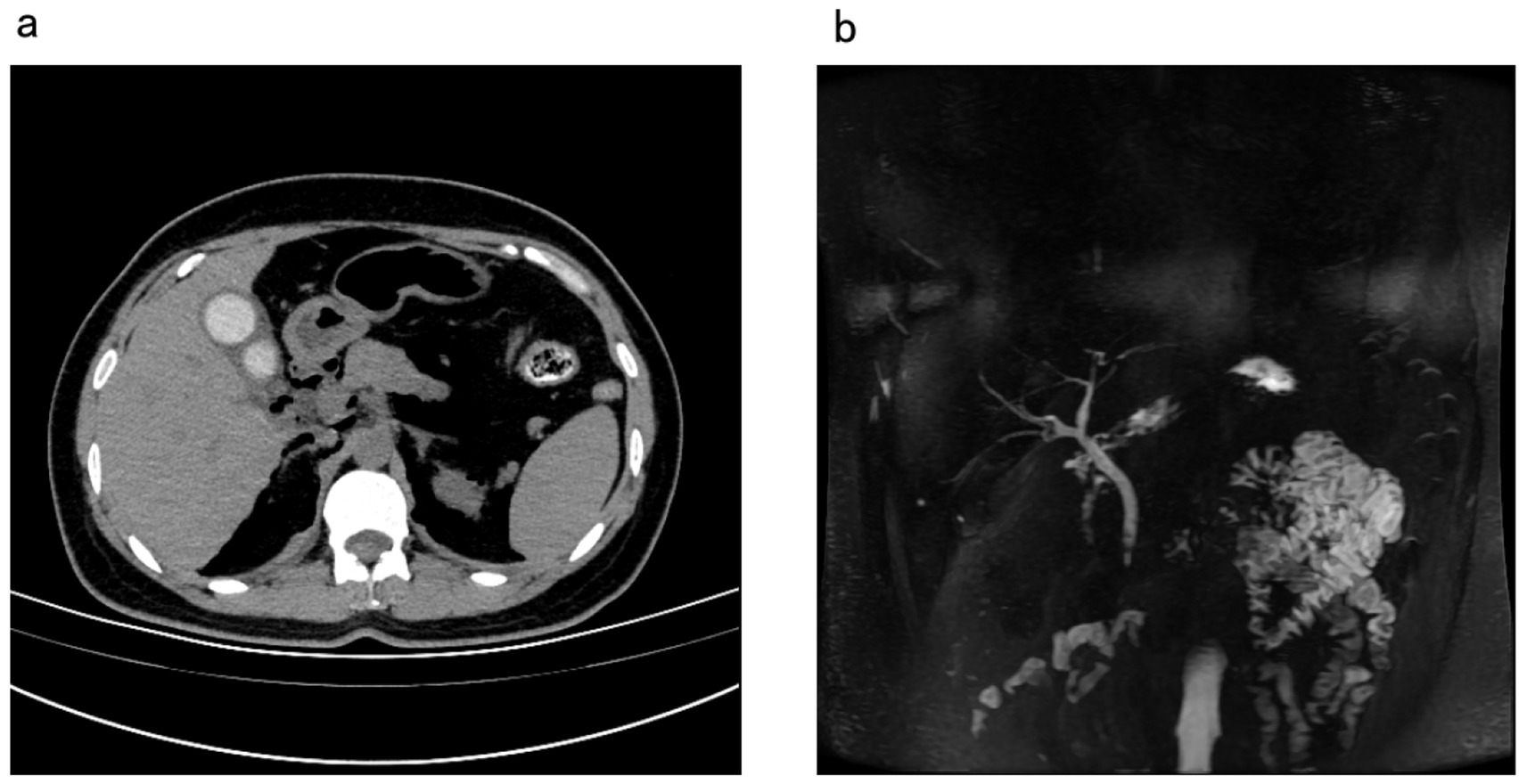
Figure 1. Patient’s abdomen MRI and MRCP before the ERCP treatment; (a) signs of cholecystitis and gallstones; (b) stone signs in the common bile duct. ERCP, endoscopic retrograde cholangiopancreatography; MRCP, magnetic resonance cholangiopancreatography; MRI, magnetic resonance imaging.
Initially, she received treatment for ERCP, EST, and EPLBD. The sediment-like stones were picked out from the CBD, and the previously observed filling defects in the ERCP examination disappeared. However, the placement of the naso-biliary tube was unsuccessful. In the procedure, no obvious perforations were observed. Although she had received those treatments, the patient still complained of upper abdominal pain.
Two days later, the symptom of upper abdominal pain persisted. Importantly, the subcutaneous emphysema was palpated in her neck and upper chest area on examination. Then, the computed tomography (CT) results showed that there were numerous gas density shadows in her bilateral neck, submaxillary region, right maxillofacial area, and retropharyngeal and parapharyngeal space, as well as in the soft tissue in front of the cervical vertebra, mediastinum, bilateral chest subcutaneous, and upper abdominal cavity (Figures 2a–c). The volume and density of the gallbladder obviously increased, with some low-density shadows mixed in it (Figures 2d,e). At this time, the WBC count was normal, 9.2 × 10^9/L, but the neutrophils count increased, 8.05 × 10^9/L (reference range, 1.8 to 6.3). The next day, the WBC count suddenly increased to 24.7 × 10^9/L, and the neutrophil count was high at 22.34 × 10^9/L. In addition, the hypersensitivity C-reactive protein (hs-CRP) level was very high, 126.18 mg/L (reference range, 0 to 10), and the procalcitonin level reached 26.1 ng/mL (reference range <0.5).
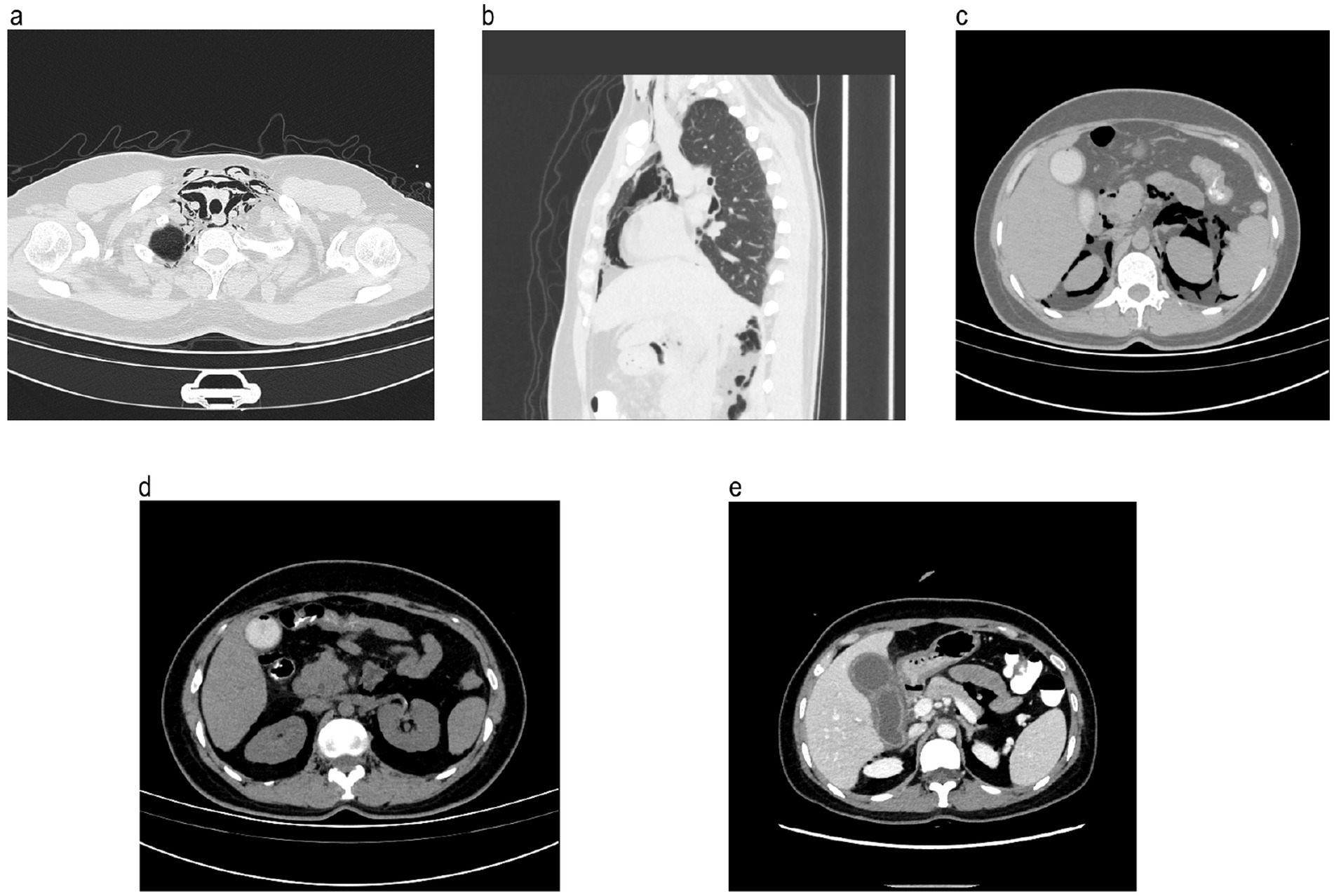
Figure 2. Patient’s computed tomography of the abdomen and chest after the ERCP treatment; (a) gas density shadows in the soft tissue in front of the cervical vertebra; (b) gas density shadows in the mediastinum and bilateral chest subcutaneous; (c), gas density shadows in the upper abdominal cavity; (d) gas density shadows in the gallbladder; and (e) the volume and density of gallbladder obviously increased within some low-density shadows. ERCP, endoscopic retrograde cholangiopancreatography.
This patient was diagnosed with ERCP-related perforation accompanied by severe infections. The relationships between perforation and severe infections were nebulous. Choosing either the conservative treatment or surgical intervention had numerous risks, which may be a critical life-threatening decision. As for potential reasons of the massive abdominal and thoracic gas along with severe infections, the simple severe infections in the retroperitoneum, perforation-related pancreatic fistula, intestinal fistula, and bile leak were taken into consideration. The two events, namely, severe infections and massive abdominal and thoracic gas, might be unrelated. Therefore, the multi-disciplinary treatment was conducted.
The next day, the patient received conservative treatment, including antibiotic treatment (Sulperazon) and gastrointestinal decompression therapy. Meanwhile, the results of the following upper gastrointestinal radiography examination did not indicate any signs of gastrointestinal perforations (Figure 3). Then, given the severe cholecystitis, the patient received the percutaneous transhepatic gallbladder drainage therapy (PTGD), and the result of bile culture showed the infection of Morganella morganii. Fortunately, this microorganism was sensitive to the use of antibiotic treatment.
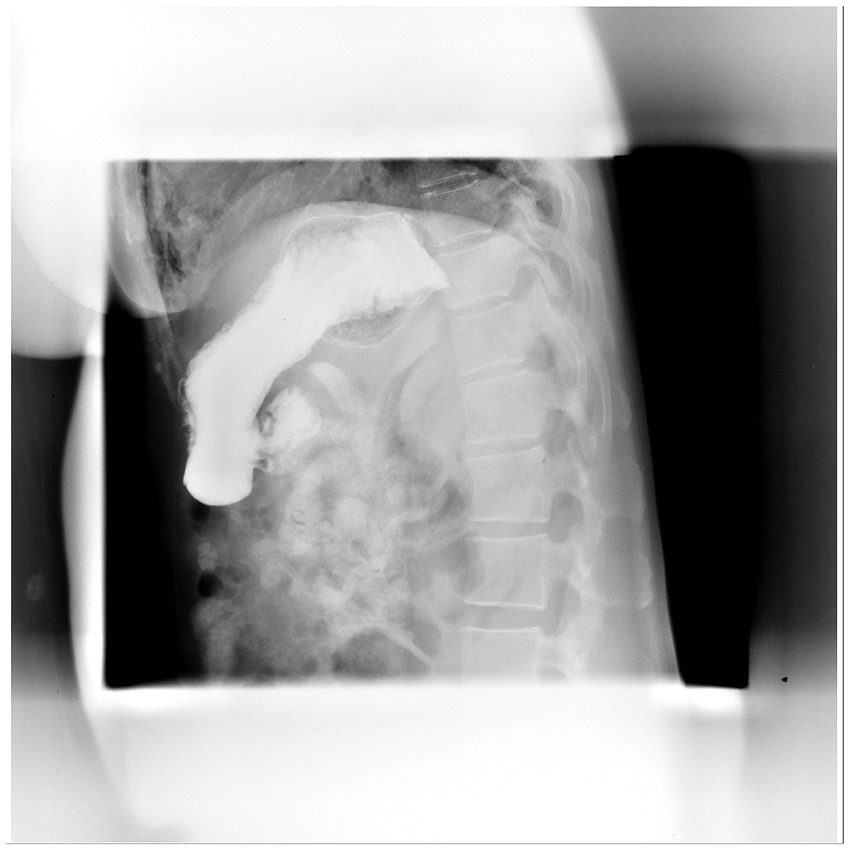
Figure 3. No signs of gastrointestinal perforation in the upper gastrointestinal radiography examination.
Two days later, the results of the CT examination showed that gas density shadows in the patient’s bilateral neck, submaxillary, right maxillofacial, and retropharyngeal and parapharyngeal space, as well as in the soft tissue in front of cervical vertebra, mediastinum, bilateral chest subcutaneous, and upper abdominal cavity reduced in some degree, compared to the previous examination. There was no new extra effusion in those tissues. Importantly, the level of hs-CRP and procalcitonin of this patient dropped to 61.02 mg/L and 15.18 ng/mL, respectively.
Five days following the PTGD therapy, the abdomen tenderness disappeared, and all of the inflammation markers, including the WBC counts, remained within normal ranges (Figure 4). Ultimately, the patient underwent laparoscopic cholecystectomy and was discharged safely.
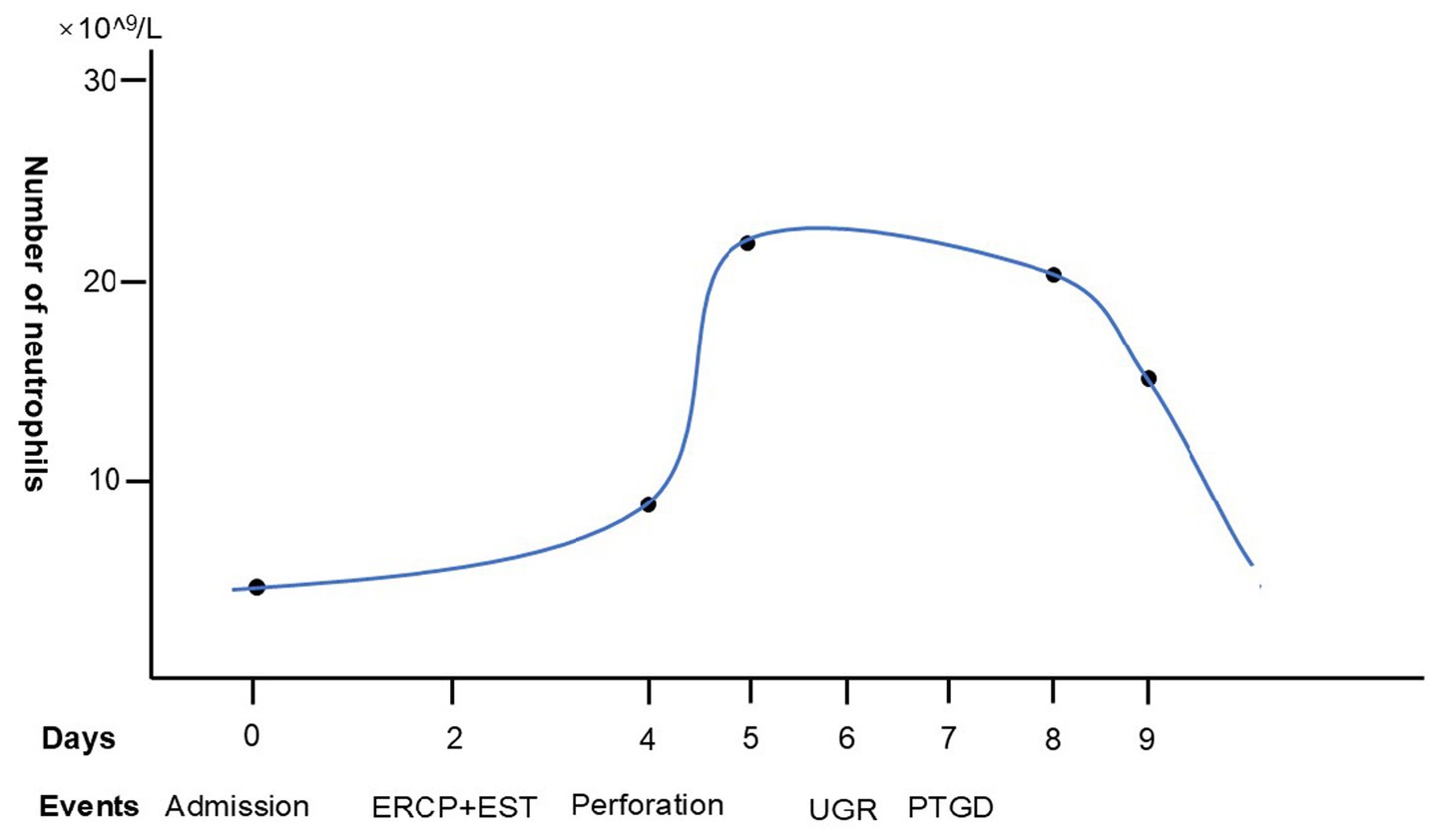
Figure 4. Number of blood neutrophil count of the patient in the whole diagnosis and treatment process. ERCP, endoscopic retrograde cholangiopancreatography; EST, endoscopic sphincterotomy; UGR, upper gastrointestinal radiography; PTGD, percutaneous transhepatic gallbladder drainage.
3 Discussion and literature review
A rare case was reported of a patient presenting massive diffuse gas in many tissues accompanied by severe infections after undergoing the ERCP treatment. Based on the PTGD and antibiotics therapy, the patient was relieved from the terrible injury without receiving the surgical intervention.
Perforation was a quite unusual ERCP-related complication. The incidence of ERCP-related perforation was always lower than 3% (3, 8–10). A few patients were diagnosed with perforation after 24 h of the ERCP procedures (9/75, 12.0%) (11). The classical four classes of ERCP-related perforations (Stapfer types) were first posed in the 2000 years (5), and this classification was widely used due to its great value in guiding treatments. The number of Stapfer IV injuries (retroperitoneal air alone) was small (9/63, 14.28%) in the patients with perforations (4). However, in the large part of patients with perforations, the multi-organ failure was the high-risk factor of mortality, including infections (9/62, 15.0%) (3). Thus, in clinical practice, patients with complex Stapfer IV injuries accompanied by severe infections should be closely cared.
In the following parts, treatments of different types of Stapfer IV injury were reviewed (Figure 5).
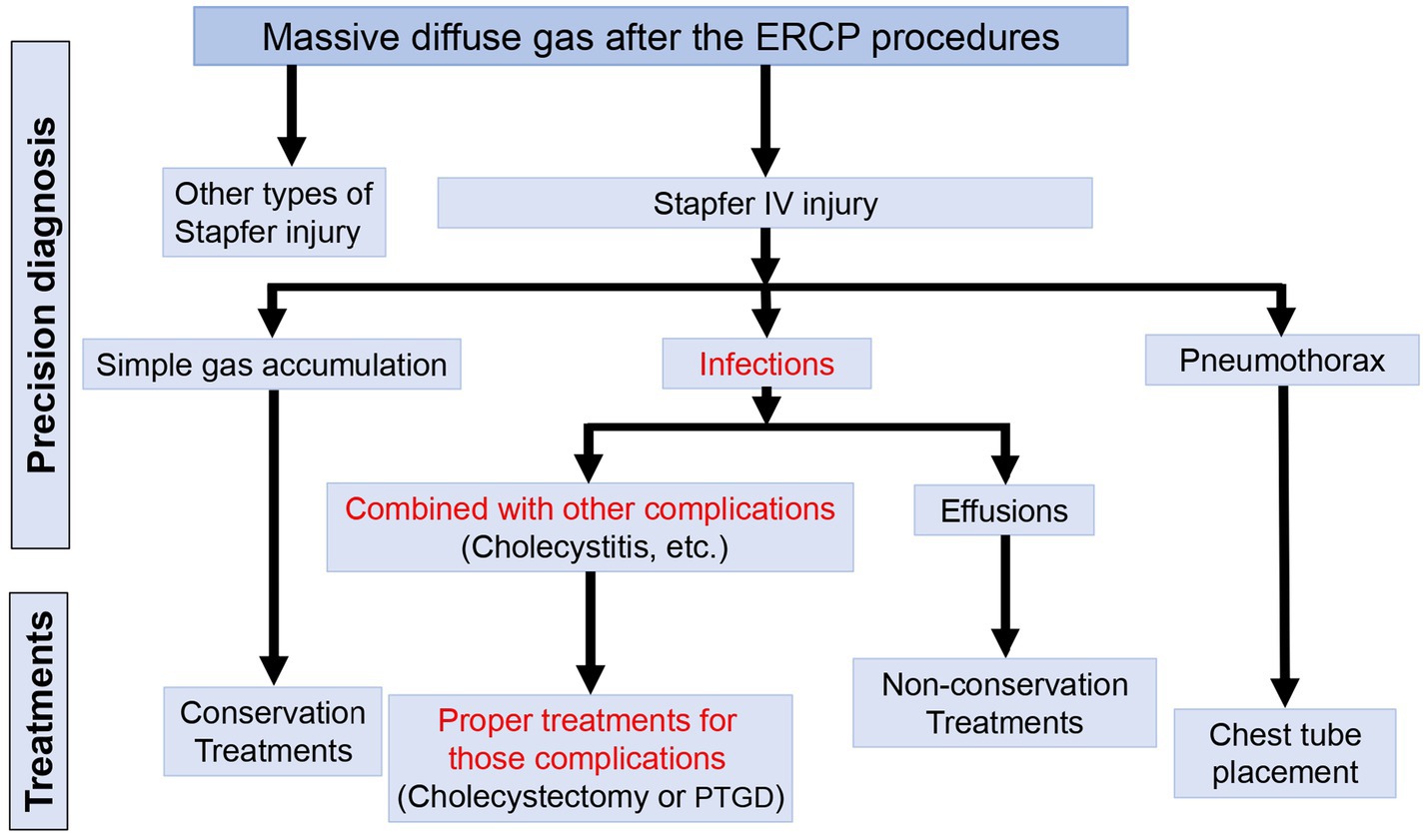
Figure 5. Flow gram of treatments for different types of Stapfer IV injury. ERCP, endoscopic retrograde cholangiopancreatography; PTGD, percutaneous transhepatic gallbladder drainage.
3.1 Treatments for simple Stapfer IV injury
Simple Stapfer IV injury may not be a true perforation (5). In our case, the negative result of the upper gastrointestinal radiography examination, which failed to identify the perforation location, supported this perspective. The probable mechanism of Stapfer IV injury involved the numerous compressed airs along the perineural and perivascular sheath flight into the mediastinum (12). Another possible mechanism was that prolonged air insufflation caused air to dissect through the retroperitoneum and peritoneal cavity into the pleural space, mediastinum, and subcutaneous tissue of neck. Placement of a naso-biliary tube after the ERCP procedure or avoiding numerous and prolonged compressed air insufflation in the whole ERCP procedure might reduce the occurrence of simple Stapfer IV injury (13). According to the above pathological mechanism, conservative management was appropriate for the simple Stapfer IV injury (14). Stapfer IV injury may not be an absolute indication for surgical exploration (15).
3.2 Treatments for Stapfer IV injury along with pneumothorax
However, some special interventions for complex Stapfer IV injury must be considered. Some patients experienced Stapfer IV injury accompanied by pneumothorax (16–18). The chest tube placement treatment for that circumstance could be effective (19–21). The previous study showed that the massive bilateral chest subcutaneous gas was one of the surgical indications for this type of Stapfer IV injury (5).
3.3 Treatments for Stapfer IV injury along with infections
Under the background of ERCP-related perforation, the patient with severe infections must be noted. Previous studies reported that the sepsis may indicate surgical interventions (22). Antibiotic therapy and intensive care were necessary. However, investigating the source of infections and assessing the correlation between perforation and infections were two key steps to successful treatment. The presence of effusion collection in the retroperitoneal or peritoneum could have indicated the potential relationship between perforation and infections. In these circumstances, surgical interventions should be considered (23).
When patients presented with Stapfer IV injury and infections without effusion collection, other complications of ERCP procedures might exist, including cholecystitis. The rapid occurrence of cholecystitis after the ERCP procedure was rare (24). The coexistence of severe cholecystitis and Stapfer IV injury is quite rare, and there is no standard treatment scheme for this particular case currently. Different from the positive surgical exploring indications in previous studies (5), patients with severe cholecystitis after the ERCP-related perforation could be treated successfully without surgical interventions. In addition, surgical interventions could be considered for treating cholecystitis or other complications of ERCP procedures, not just for the Stapfer IV injury.
3.4 Potential bacterial translocation in Stapfer IV injury
Morganella morganii, as a part of the normal flora in the intestinal tracts (25), was not a common pathogen of cholangitis. It was rarely identified in bile cultures from the gallbladder. Infection of Morganella morganii in the gallbladder might be associated with the Stapfer IV injury as a few gases were detected in the patient’s gallbladder. This sign may reveal that compressed air in the Stapfer IV injury might carry some normal flora to other parts of the body, leading to life-threatening infections. However, none of these types of cases have been reported in the previous literature. In this situation, surgical interventions could be operated for the cholangitis. To mitigate the risk of infection and Stapfer IV injury, adherence to standardized ERCP operation was essential. In addition, preventive usage of antibiotics could reduce the risk of infections in some high-risk patients (26).
4 Conclusion
Conservative treatment for simple Stapfer IV injury was feasible and reliable. Stapfer IV injury patients with pneumothorax could recover through the placement of a chest tube. When severe infection occurs in patients with Stapfer IV injury, other complications of ERCP procedures, cholecystitis, should be taken into consideration. Surgical interventions for the source of infections, not just for the Stapfer IV injury, might be effective.
Data availability statement
The original contributions presented in the study are included in the article/supplementary material, further inquiries can be directed to the corresponding author.
Ethics statement
This study was conducted in accordance with the principles of the Declaration of Helsinki. The study was reviewed and approved by the Institutional Review Board of Suining Central Hospital. The studies were conducted in accordance with the local legislation and institutional requirements. The ethics committee/institutional review board waived the requirement of written informed consent for participation from the participants or the participants’ legal guardians/next of kin because this study was conducted in accordance with the principles of the Declaration of Helsinki. The study was reviewed and approved by the Institutional Review Board of Suining Central Hospital. Written informed consent was obtained from the individual(s) for the publication of any potentially identifiable images or data included in this article.
Author contributions
HL: Data curation, Formal analysis, Supervision, Visualization, Writing – original draft, Writing – review & editing. MY: Data curation, Project administration, Writing – original draft. Y-JL: Visualization, Writing – review & editing.
Funding
The author(s) declare that financial support was received for the research and/or publication of this article. The funding for this article was provided by the Science and Technology Project of Sichuan Provincial Health Commission (No. 23LCYJ002).
Conflict of interest
The authors declare that the research was conducted in the absence of any commercial or financial relationships that could be construed as a potential conflict of interest.
Generative AI statement
The authors declare that no Gen AI was used in the creation of this manuscript.
Publisher’s note
All claims expressed in this article are solely those of the authors and do not necessarily represent those of their affiliated organizations, or those of the publisher, the editors and the reviewers. Any product that may be evaluated in this article, or claim that may be made by its manufacturer, is not guaranteed or endorsed by the publisher.
References
1. Manes, G, Paspatis, G, Aabakken, L, Anderloni, A, Arvanitakis, M, Ah-Soune, P, et al. Endoscopic management of common bile duct stones: European Society of Gastrointestinal Endoscopy (ESGE) guideline. Endoscopy. (2019) 51:472–91. doi: 10.1055/a-0862-0346
2. Freeman, ML, Nelson, DB, Sherman, S, Haber, GB, Herman, ME, Dorsher, PJ, et al. Complications of endoscopic biliary sphincterotomy. N Engl J Med. (1996) 335:909–19. doi: 10.1056/nejm199609263351301
3. Langerth, A, Isaksson, B, Karlson, BM, Urdzik, J, and Linder, S. ERCP-related perforations: a population-based study of incidence, mortality, and risk factors. Surg Endosc. (2020) 34:1939–47. doi: 10.1007/s00464-019-06966-w
4. Bill, JG, Smith, Z, Brancheck, J, Elsner, J, Hobbs, P, Lang, GD, et al. The importance of early recognition in management of ERCP-related perforations. Surg Endosc. (2018) 32:4841–9. doi: 10.1007/s00464-018-6235-8
5. Stapfer, M, Selby, RR, Stain, SC, Katkhouda, N, Parekh, D, Jabbour, N, et al. Management of duodenal perforation after endoscopic retrograde cholangiopancreatography and sphincterotomy. Ann Surg. (2000) 232:191–8. doi: 10.1097/00000658-200008000-00007
6. Shimizu, T, Yoshioka, M, Matsushita, A, Kaneko, K, Ueda, J, Kawashima, M, et al. Causes and Management of Endoscopic Retrograde Cholangiopancreatography-Related Perforation: a retrospective study. J Nippon Med School. (2023) 90:316–25. doi: 10.1272/jnms.JNMS.2023_90-305
7. Tasar, P, and Kilicturgay, SA. Early results of conservative and surgical approach in endoscopic retrograde cholangiopancreatography (ERCP) perforations single center experience. Ann Ital Chir. (2023) 94:367–74.
8. Andriulli, A, Loperfido, S, Napolitano, G, Niro, G, Valvano, MR, Spirito, F, et al. Incidence rates of post-ERCP complications: a systematic survey of prospective studies. Am J Gastroenterol. (2007) 102:1781–8. doi: 10.1111/j.1572-0241.2007.01279.x
9. Loperfido, S, Angelini, G, Benedetti, G, Chilovi, F, Costan, F, De Berardinis, F, et al. Major early complications from diagnostic and therapeutic ERCP: a prospective multicenter study. Gastrointest Endosc. (1998) 48:1–10. doi: 10.1016/s0016-5107(98)70121-x
10. Patil, NS, Solanki, N, Mishra, PK, Sharma, BC, and Saluja, SS. ERCP-related perforation: an analysis of operative outcomes in a large series over 12 years. Surg Endosc. (2020) 34:77–87. doi: 10.1007/s00464-019-06733-x
11. Fatima, J, Baron, TH, Topazian, MD, Houghton, SG, Iqbal, CW, Ott, BJ, et al. Pancreaticobiliary and duodenal perforations after periampullary endoscopic procedures: Diagnosis and management. Arch Surg. (2007) 142:448. doi: 10.1001/archsurg.142.5.448
12. Yilmaz, B, Roach, EC, Koklu, S, Aydin, O, Unlu, O, and Kilic, YA. Air leak syndrome after endoscopic retrograde cholangiopancreatography: a rare and fatal complication. World J Gastroenterol. (2015) 21:4770–2. doi: 10.3748/wjg.v21.i15.4770
13. Assimakopoulos, SF, Thomopoulos, KC, Giali, S, Triantos, C, Siagris, D, and Gogos, C. A rare etiology of post-endoscopic retrograde cholangiopancreatography pneumoperitoneum. World J Gastroenterol. (2008) 14:2917–9. doi: 10.3748/wjg.14.2917
14. Goddard, AG, McConomy, B, Bathla, G, Furqan, M, and Silverman, WB. Air leakage in multiple compartments after endoscopy. Cleve Clin J Med. (2016) 83:705–7. doi: 10.3949/ccjm.83a.15168
15. Miao, YS, Li, YY, Cheng, BW, Zhan, YF, Zeng, S, Zhou, XJ, et al. Clinical analysis of 45 cases of perforation were identified during endoscopic retrograde cholangiopancreatography procedure. Front Med. (2022) 9:1039954. doi: 10.3389/fmed.2022.1039954
16. Rappaport, DE, Solano, JJ, and Edlow, JA. Bilateral Pneumothoraces as a complication of endoscopic retrograde cholangiopancreatography. J Emerg Med. (2017) 52:573–5. doi: 10.1016/j.jemermed.2016.11.023
17. Garmon, EH, Contreras, E, and Conley, J. Tension pneumothorax and widespread pneumatosis after endoscopic retrograde cholangiopancreatography. Anesthesiology. (2013) 119:699. doi: 10.1097/ALN.0b013e31827bcdba
18. Song, SY, Lee, KS, Na, KJ, and Ahn, BH. Tension pneumothorax after endoscopic retrograde pancreatocholangiogram. J Korean Med Sci. (2009) 24:173–5. doi: 10.3346/jkms.2009.24.1.173
19. Fujii, L, Lau, A, Fleischer, DE, and Harrison, ME. Successful nonsurgical treatment of Pneumomediastinum, pneumothorax, pneumoperitoneum, Pneumoretroperitoneum, and subcutaneous emphysema following ERCP. Gastroenterol Res Pract. (2010) 2010:289135:1–7. doi: 10.1155/2010/289135
20. Schepers, NJ, and van Buuren, HR. Pneumothorax following ERCP: report of four cases and review of the literature. Dig Dis Sci. (2012) 57:1990–5. doi: 10.1007/s10620-012-2150-3
21. Markogiannakis, H, Toutouzas, KG, Pararas, NV, Romanos, A, Theodorou, D, and Bramis, I. Bilateral pneumothorax following endoscopic retrograde cholangiopancreatography: a case report. Endoscopy. (2007) 39:E195. doi: 10.1055/s-2007-966416
22. Alfieri, S, Rosa, F, Cina, C, Tortorelli, AP, Tringali, A, Perri, V, et al. Management of duodeno-pancreato-biliary perforations after ERCP: outcomes from an Italian tertiary referral center. Surg Endosc. (2013) 27:2005–12. doi: 10.1007/s00464-012-2702-9
23. Jiang, X, Wang, M, Fu, M, Cheng, Y, Zhao, L, and Fan, Z. Minimally invasive management of persistent retroperitoneal infections following ERCP duodenal perforations. Rev Esp Enferm Dig. (2024). [Online ahead of Print]. doi: 10.17235/reed.2024.10522/2024
24. Itah, R, Bruck, R, Santo, M, Skornick, Y, and Avital, S. Gangrenous cholecystitis - a rare complication of ERCP. Endoscopy. (2007) 39:E223–4. doi: 10.1055/s-2007-966549
25. Liu, H, Zhu, J, Hu, Q, and Rao, X. Morganella morganii, a non-negligent opportunistic pathogen. Int J Infect Dis. (2016) 50:10–7. doi: 10.1016/j.ijid.2016.07.006
Keywords: endoscopic retrograde cholangiopancreatography, infections, Stapfer IV injury, cholecystitis, pneumothorax, conservative treatment
Citation: Liang H, Yang M and Liu Y-J (2025) Treatments for different types of ERCP-related Stapfer IV injury: a case report and literature review. Front. Med. 12:1549795. doi: 10.3389/fmed.2025.1549795
Edited by:
Huseyin Kemal Rasa, Anadolu Medcal Center Hospital, TürkiyeReviewed by:
Mehmet Eryilmaz, Gulhane Military Medical Academy, TürkiyeArda Isik, Istanbul Medeniyet University, Türkiye
Tufan Egeli, Dokuz Eylül University, Türkiye
Copyright © 2025 Liang, Yang and Liu. This is an open-access article distributed under the terms of the Creative Commons Attribution License (CC BY). The use, distribution or reproduction in other forums is permitted, provided the original author(s) and the copyright owner(s) are credited and that the original publication in this journal is cited, in accordance with accepted academic practice. No use, distribution or reproduction is permitted which does not comply with these terms.
*Correspondence: Yuan-Jun Liu, bHlqZG9jdG9yQHNpbmEuY29t
 Hao Liang
Hao Liang Min Yang
Min Yang Yuan-Jun Liu
Yuan-Jun Liu